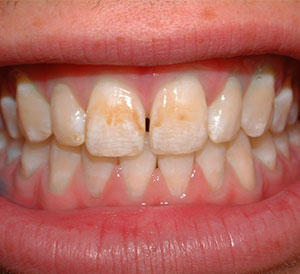Teeth Discoloration Treatment

We like to smile; we like to make people smile. We have often read that a smile has changed a man’s life in a fiction. Do you wonder, sometimes, how some warm, silent smiles in the big chambers of the world may also have resolved the possibilities of various wars and have shaped our history the way we know it?
But what happens if this smile is stained? Stained teeth steal the charm from even the warmest and most genuine smile. When you look at a set of yellow teeth, you judge the person instantly for poor oral hygiene. But, the fact is teeth can naturally be mild yellowish without signifying any Dental health issues.
However, certain external factors and some internal issues might cause your teeth to show non-white colours. Teeth stains are culturally of high cosmetic significance. At Dr Gowds, we can take care of either kind with expertise.
Extrinsic Stains: Extrinsic stains are the stains caused due to external factors. The cup of coffee that helps you get energised in the morning, also colours your teeth, but not in a good way. Not just coffee, there are various other food items and other daily habits which kill the white (and thus, the glamour) of our teeth.
When you stain your teeth, you are actually staining the outermost layer of the teeth, called the enamel. This kind of staining results from excess oral contact with dark-colored substances. Tiny particles of these foods and substances get trapped in your enamel. This causes the enamel to darken.
Some foods which you should keep an eye out are:
- Tea & Coffee: Tea and coffee are imbibed in our cultural practices. We need a cup of tea before making breakfast, we need a cup of coffee after meetings. Over time, such practices stain your teeth. The best way to avoid that is to sip your beverage soon and rinse thoroughly afterwards.
- Wine and Sodas: A glass of wine in a social gathering never hurt anyone. Or does it? Yes, your teeth are at risk. Why just wine? Any alcohol or even dark coloured soft or aerated drinks are bad for your dental health, not just dental looks.
Do you have a habit of topping your alcohol up with a serve of soda? Well, then it’s ‘bye bye white teeth’. - Smoking or Chewing Tobacco: How many times have you heard that smoking and chewing tobacco are bad? That they shorten your lifespan? But, you still never did anything about it (except maybe thinking to quit). This is probably because you are reluctant to think about issues which will show up years later. But here is an issue that shows up in weeks – these bad habits ruin the colour of your enamel within a couple of weeks.
- Dark vegetables: Little children get fascinated at how their poop changes colour when they eat a lot of spinach or carrots or beetroot. But we adults need to see that they (and of course, we) brush after eating vegetables which has a dark colour because otherwise, they will stain our teeth.
- Colourful spices: India is the land of spices. (Which attracted a lot of colonisers to our land – but let’s not go there now). Our dishes make wonderful Instagram pages, thanks to saffron, turmeric, red chilli, cilantro and many more. They not only add colour but also have health benefits. But be cautious because they are slowly staining your teeth.
Intrinsic Stains: Intrinsic stains are not as common as extrinsic stains. Intrinsic stains occur when there is a discoloration due to a factor rooted deeper (than enamel) within the tooth’s structure. These may signify more than just a challenged cosmetic appeal – these may be symptoms of other health issues or serious dental problems. Intrinsic stains typically give your teeth a grey or a yellow or a blue hue.
The below mentioned factors may cause intrinsic stains:
- Dental fractures: Small cracks in your tooth’s enamel allow the factors which cause the extrinsic stains to discolour the inside of your tooth.
- Tetracycline antibiotics: If a pregnant lady takes tetracycline antibiotics, it can cause the Child’s teeth to turn grey later on because of the chemical composition present in the medicine.
- Dental trauma: Bleeding within your tooth’s dentin, or a pulp infection that needs a Root canal therapy can make the colour of your teeth appear different.
- Tooth decay: Tooth decay or erosion of enamel makes the inner layer of your teeth, called dentin, more vulnerable to the staining particles.
- Developmental or genetic issues: Some people are naturally born with a thin enamel. While for some it can be a developmental issue, others are genetically predisposed with a thin enamel. This may make your teeth look bluish.
- Other teeth Conditions: Dental Fluorosis and Amelogenesis imperfecta are two teeth conditions where there is a defect in formation of enamel. While they are no direct dental hazards, they raise cosmetic concerns.
Teeth whitening treatment requires the expertise of a professional. Most procedures involve gels and solutions that are medically tested and approved. But none of them are churned out from a Witch’s Cauldron. Hence, we may not be able to make your teeth glow in the dark but, at our clinic, we will assess your condition and discuss with you all your treatment options.
The ‘active ingredient’ in most teeth whitening products is hydrogen peroxide. Hydrogen peroxide breaks down and the oxygen gets inside the enamel on the teeth. A reaction between the oxygen and the enamel changes the colour of the teeth to a lighter shade. Teeth whitening is an effective way of lightening the colour of your teeth without disturbing the tooth surface and enamel. Although it cannot completely change the colour of the teeth, it may lighten the existing shade and give a shiny look.






